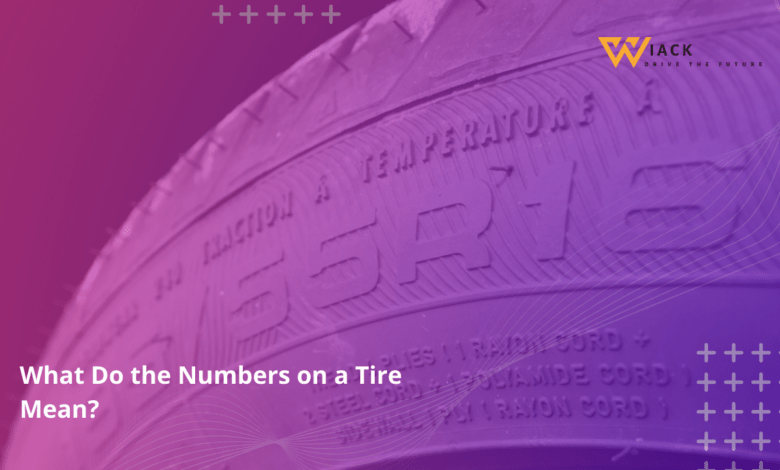What Do the Numbers on a Tire Mean?

Did you know that over 20 million Americans choose the wrong type of tires for their vehicles each year? This staggering statistic highlights the importance of understanding what the numbers on a tire mean. Whether you’re a seasoned driver or new to the world of automotive maintenance, decoding the information on your tire’s sidewall is crucial for ensuring your safety, optimizing your vehicle’s performance, and making informed decisions when it’s time for a replacement. In this comprehensive guide, we’ll explore every aspect of tire markings, from size specifications to quality ratings, helping you become an expert in understanding your tires.
Understanding Tire Sizes
The most prominent numbers on your tire’s sidewall represent its size. These numbers are crucial for ensuring that you choose the right tire for your vehicle. Let’s break down each component of the tire size designation:
Tire Width
The first number you’ll see in a tire size is the tire width. This measurement is expressed in millimeters and represents the width of the tire from sidewall to sidewall. For example, in a tire size like 225/45R18, the number 225 indicates that the tire is 225 millimeters wide.
Why is tire width important? A wider tire generally provides:
- Better traction and grip on dry roads
- Improved cornering stability
- Enhanced aesthetic appeal
However, wider tires can also:
- Increase rolling resistance, potentially reducing fuel efficiency
- Be more prone to hydroplaning in wet conditions
When considering changing your tire width, it’s essential to ensure that the new size is compatible with your vehicle’s wheel wells and suspension system.
Aspect Ratio
Following the tire width, you’ll see a forward slash and another number. This number represents the tire’s aspect ratio. In our example of 225/45R18, the aspect ratio is 45. But what does this number mean?
The aspect ratio is the height of the tire’s sidewall expressed as a percentage of its width. In this case, the sidewall height is 45% of the tire’s width. To calculate the actual height of the sidewall:
- Convert the width to inches: 225 mm ≈ 8.86 inches
- Calculate 45% of 8.86 inches: 8.86 x 0.45 = 3.99 inches
So, the sidewall height of this tire is approximately 4 inches.
Understanding aspect ratio is important because it affects:
- Ride comfort: Higher aspect ratios generally provide a smoother ride
- Handling: Lower aspect ratios often offer better handling and responsiveness
- Tire durability: Lower profile tires (lower aspect ratios) may be more susceptible to damage from potholes and road debris
Wheel Diameter
The last number in the main tire size designation represents the wheel diameter in inches. In our 225/45R18 example, the 18 indicates that this tire is designed to fit an 18-inch wheel.
It’s crucial to match the tire’s wheel diameter to your vehicle’s wheels. Using a tire with the wrong wheel diameter can result in:
- Improper fitment
- Inaccurate speedometer readings
- Potential safety hazards
When shopping for new tires, always ensure that the wheel diameter matches your vehicle’s specifications.
Load Index
After the wheel diameter, you’ll often see a number followed by a letter. The number represents the tire’s load index. This index corresponds to the maximum weight the tire can support when properly inflated. For example, a load index of 95 indicates that the tire can support up to 1,521 pounds.
Here’s a small sample of load index values and their corresponding weight capacities:
| Load Index | Maximum Weight (lbs) |
|---|---|
| 85 | 1,135 |
| 90 | 1,323 |
| 95 | 1,521 |
| 100 | 1,764 |
It’s essential to choose tires with a load index that meets or exceeds your vehicle manufacturer’s recommendations to ensure safe operation.
Speed Rating
The letter following the load index is the tire’s speed rating. This rating indicates the maximum speed at which the tire can safely operate. Speed ratings are represented by letters, with each letter corresponding to a specific maximum speed.
Here’s a quick reference for common speed ratings:
| Speed Rating | Maximum Speed (mph) |
|---|---|
| S | 112 |
| T | 118 |
| H | 130 |
| V | 149 |
| W | 168 |
| Y | 186 |
Always choose tires with a speed rating that meets or exceeds your vehicle manufacturer’s recommendations, even if you don’t plan on driving at high speeds. Higher speed ratings often indicate better overall performance and handling characteristics.
Other Markings on Tires
While the size designation provides crucial information, there are many other markings on your tire’s sidewall that offer valuable insights. Let’s explore these additional markings:
Tire Type
The first letter in the tire size designation indicates the tire type. Common tire types include:
- P: Passenger vehicle tire
- LT: Light Truck tire
- ST: Special Trailer tire
- T: Temporary (spare) tire
This designation helps you quickly identify whether the tire is appropriate for your vehicle type. For example, using an LT tire on a passenger vehicle could result in a harsher ride, while using a P tire on a light truck might not provide adequate load capacity.
Tire Construction
In our 225/45R18 example, the “R” stands for Radial construction. This indicates that the tire’s internal ply cords are oriented radially, running perpendicular to the direction of travel. Radial tires are the most common type used today due to their superior performance and durability.
Other construction types you might encounter include:
- B: Bias-ply construction
- D: Diagonal construction
Radial tires offer several advantages over other construction types:
- Better traction and handling
- Improved fuel efficiency
- Longer tread life
- Enhanced ride comfort
Treadwear Rating
The treadwear rating is a comparative rating based on the wear rate of the tire when tested under controlled conditions. A tire with a grade of 200 should last twice as long as a tire graded 100. However, it’s important to note that actual on-road treadwear can vary significantly based on driving habits, road conditions, and climate.
Treadwear ratings typically range from 60 to 620, with higher numbers indicating longer expected tread life. When comparing tires, use the treadwear rating as a general guide, but remember that it’s not a guarantee of actual mileage you’ll achieve.
Traction Rating
The traction rating indicates a tire’s ability to stop on wet pavement. Traction grades are assigned based on the tire’s performance in standardized tests. The grades, from highest to lowest, are:
- AA
- A
- B
- C
A tire with an AA rating should provide the best wet traction, while a C-rated tire meets the minimum safety standards. When choosing tires, consider opting for those with higher traction ratings, especially if you frequently drive in wet conditions.
Temperature Rating
The temperature rating represents a tire’s ability to dissipate heat under load. Proper heat dissipation is crucial for maintaining tire integrity and preventing blowouts. Temperature grades, from highest to lowest, are:
- A
- B
- C
A tire rated A should be able to withstand higher speeds without overheating compared to B or C rated tires. All tires sold in the United States must meet at least a C rating, which corresponds to the ability to withstand speeds up to 85 mph without failure.
DOT Code
The DOT (Department of Transportation) code is a series of numbers and letters that provide information about the tire’s manufacturer, size, and date of production. While most of this code is used for quality control purposes, the last four digits are particularly important for consumers.
Manufacturing Date
The last four digits of the DOT code represent the manufacturing date of the tire. The first two numbers indicate the week of manufacture, while the last two represent the year. For example:
- 2619 would mean the tire was manufactured in the 26th week of 2019
Knowing the manufacturing date is crucial because tires degrade over time, even if they’re not being used. Most tire manufacturers recommend replacing tires that are 6-10 years old, regardless of tread depth.
Tire Sidewall Information
In addition to the size and ratings, your tire’s sidewall contains other valuable information:
- Maximum inflation pressure: This is the highest air pressure the tire can safely hold. It’s not necessarily the recommended pressure for your vehicle.
- Maximum load: The maximum weight the tire can support when properly inflated.
- Rotation direction: Some tires have arrows indicating the correct direction of rotation for optimal performance.
- M+S or M/S: Indicates the tire is suitable for mud and snow conditions.
Uniform Tire Quality Grading (UTQG)
The UTQG is a rating system established by the U.S. Department of Transportation to help consumers compare tire quality. It includes the treadwear, traction, and temperature ratings we discussed earlier. These ratings are typically displayed prominently on the tire’s sidewall.
Additional Information
Some tires may have additional markings indicating special features or certifications:
- Run-flat capability: Often indicated by “RFT” or a specific symbol
- Eco-friendly design: May be marked with “Eco” or a leaf symbol
- Original Equipment (OE): Tires designed specifically for certain vehicle models may have an OE designation
Understanding what the numbers on a tire mean is crucial for making informed decisions about your vehicle’s safety and performance. By decoding these markings, you can ensure you’re choosing the right tires for your needs, maintaining them properly, and replacing them when necessary.
Remember, while this guide provides a comprehensive overview of tire markings, always consult your vehicle’s owner’s manual and a professional tire specialist when making decisions about tire selection and maintenance. Your safety on the road depends on having the right tires in good condition, so take the time to understand these important numbers and symbols. With this knowledge, you’ll be better equipped to keep your vehicle running safely and efficiently for years to come.
Get the latest car news, reviews, and prices at Wiack.com. Your one-stop destination for all things automotive.





